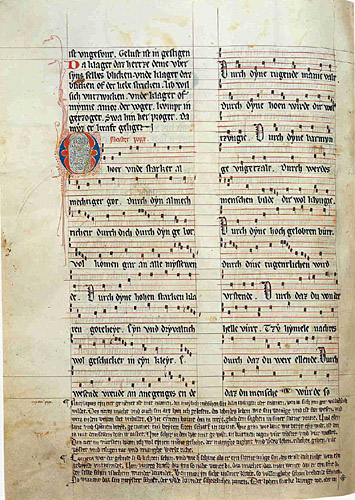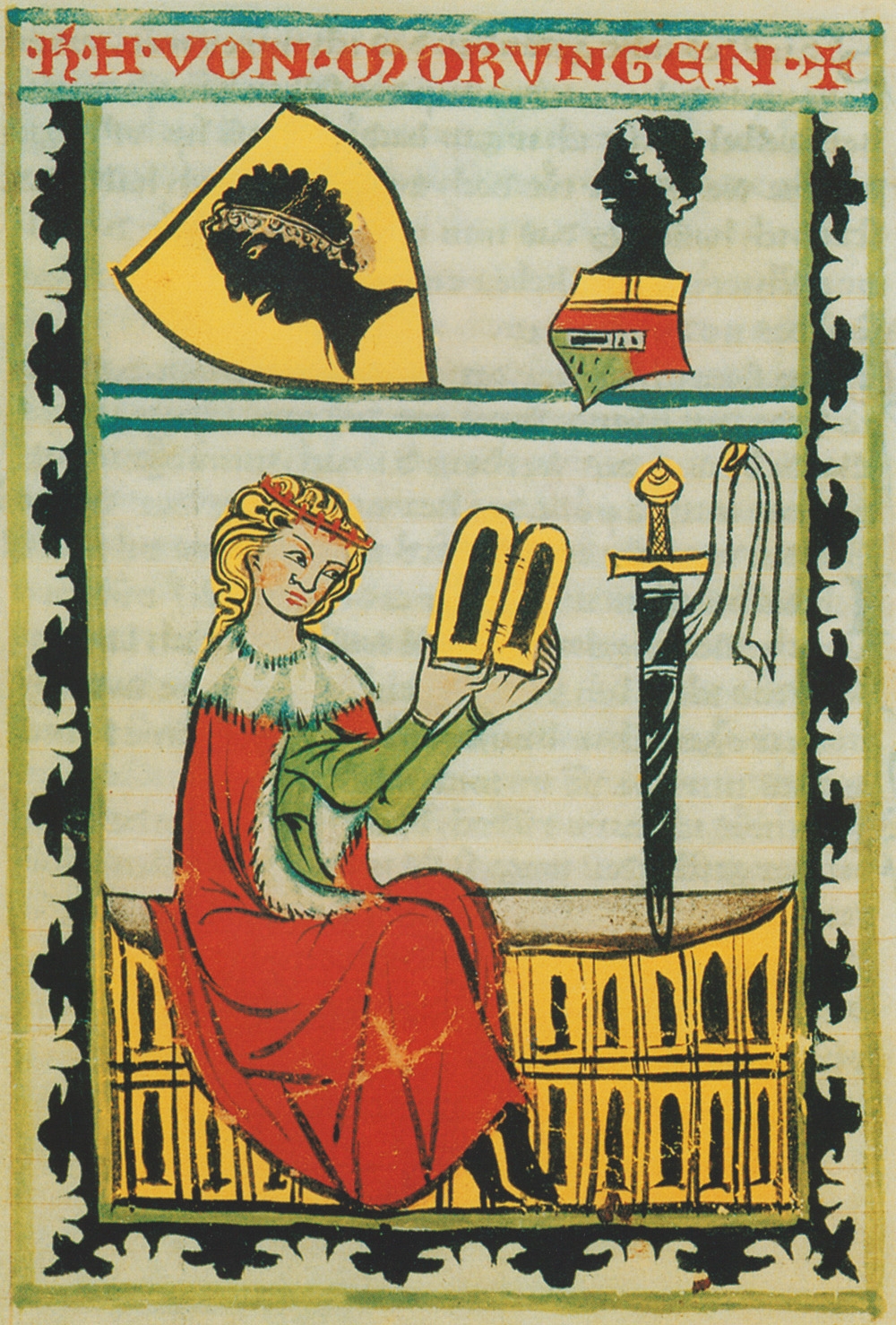|
Liederhandschrift
''Liederhandschrift'', German for ''Manuscript of the Songs'', is the German term for a manuscript containing lieder (songs) of the German Middle Ages, dating from the late 12th to the 15th centuries. Of particular importance are the Minnesang manuscripts of the 13th to 14th centuries. List of important ''Liederhandschriften'': *'' Carmina Burana'' (clm 4660/4660a), 1230 *'' Kleine Heidelberger Liederhandschrift'' (Cpg 357), late 13th century *''Codex Manesse'' (Cpg 848), ca. 1300 *'' Glogauer Liederbuch'', ''c''. 1480 *'' Heidelberger Liederhandschrift'' (Cpg 350) *'' Jenaer Liederhandschrift'' (Ms. El. f. 101), early 14th century *'' Weingartner Liederhandschrift'' or ''Stuttgarter Liederhandschrift'' (Cod. HB XIII 1), early 14th century *'' Augsburger Liederbuch'' (Cgm 379) *'' Bechsteins Handschrift'' (Cod. 14 A 39) *'' Fichards Liederbuch'' (lost) *''Liederhandschrift'' of Martin Ebenreuter (Ms. germ. fol. 488) *'' Lochamer-Liederbuch'' (Ms. Mus. 40613 Berlin, and Cgm 52 ... [...More Info...] [...Related Items...] OR: [Wikipedia] [Google] [Baidu] |
Jenaer Liederhandschrift
The Jenaer Liederhandschrift (German, the "Jena song manuscript") is a 14th-century manuscript containing lyrics and melodies to songs in Middle High German. The majority of the lyrics belong to the genre of Spruchdichtung and, with 91 melodies, the manuscript is the single most important source for the music of this genre. It is currently held in the Thuringian Universitäts- und Landesbibliothek, Jena, with the shelf-mark Ms. El. f. 101. In Minnesang scholarship it is referred to as Manuscript J. A further fragment, consisting of a single sheet, is in the in Dillingen (XV Fragm. 19). Description The manuscript comprises 133 (of an original 154) folios and contains collections of lyrics by 31 named poets, along with an anonymous religious song (a Leich), and the text of the '' Wartburgkrieg'' ("The song-contest at the Wartburg"). The quality of the manuscript is exceptional: The unusual size of the manuscript, 56 by 41 cm, the outstanding quality of the parchment, the caref ... [...More Info...] [...Related Items...] OR: [Wikipedia] [Google] [Baidu] |
Codex Manesse
The Codex Manesse (also Große Heidelberger Liederhandschrift or Pariser Handschrift) is a ''Liederhandschrift'' (manuscript containing songs), the single most comprehensive source of Middle High German ''Minnesang'' poetry, written and illustrated manuscript, illustrated between c. 1304 when the main part was completed, and c. 1340 with the addenda. The codex was produced in Zürich, for the Manesse family. The manuscript is "the most beautifully illumined German manuscript in centuries"; its 137 miniature (illuminated manuscript), miniatures are a series of "portraits" depicting each poet. Contents The Codex Manesse is an anthology of the works of a total of about 135 minnesingers of the mid 12th to early 14th century. For each poet, a portrait is shown, followed by the text of their works. The entries are ordered approximately by the social status of the poets, starting with the Holy Roman Emperor Henry VI, Holy Roman Emperor, Henry VI, Kings Conradin and Wenceslaus II of Boh ... [...More Info...] [...Related Items...] OR: [Wikipedia] [Google] [Baidu] |
Kleine Heidelberger Liederhandschrift
The Kleine Heidelberger Liederhandschift ("Small Heidelberg Song-manuscript") is a collection of Middle High German Minnesang texts. In Minnesang scholarship it is referred to as MS. A. It is held by the Heidelberg University Library with the signature Cod.Pal.germ. 357 (Cpg 357). Along with the Weingarten Manuscript (MS. B) and the Codex Manesse (MS. C), it is one of the major sources of Minnesang texts from the beginnings (around 1150) to the end of the "golden age" (around 1230). Description Dating from 1270–1280, it is the oldest of the three Upper German Minnesang manuscripts. It was created in Alsace, possibly in Strassburg. There is no certainty about the patron, though Conrad of Lichtenberg, Bishop of Strassburg has been suggested. It contains 45 parchment pages in small format (18.5 x 13.5cm), hence its name, which distinguishes it from the larger format Große Heidelberger Liederhandschrift ("Great Heidelberg Song-manuscript"), as the Codex Manesse is often called, ... [...More Info...] [...Related Items...] OR: [Wikipedia] [Google] [Baidu] |
Weingarten Manuscript
The Weingarten Manuscript (German ''Weingartner Liederhandschrift'') is a 14th-century illuminated manuscript containing a collection of Minnesang lyrics. It is currently in the Württembergische Landesbibliothek, Stuttgart, with the shelf-mark HB XIII 1. In Minnesang scholarship it is referred to as Manuscript B. Along with the Codex Manesse (MS. C) and the Kleine Heidelberger Liederhandschrift (MS. A) it is one of the major sources of Minnesang texts from the beginnings (around 1150) to the end of the "golden age" (around 1230). Description The manuscript comprises 158 folios and is 15cm×11.5cm in size, the small size suggesting that it was for private use. It contains collections of lyrics by 31 poets: 25 are named Minnesänger and the other six are not named, but the authors are identifiable from texts preserved in other MSS. The MS. contains miniatures of the 25 named Minnesänger, two half-page, the rest full-page. Most of the poems are love lyrics but among the anonymous ... [...More Info...] [...Related Items...] OR: [Wikipedia] [Google] [Baidu] |
Minnesang
(; "love song") was a tradition of lyric- and song-writing in Germany and Austria that flourished in the Middle High German period. This period of medieval German literature began in the 12th century and continued into the 14th. People who wrote and performed ''Minnesang'' were known as ''Minnesänger'' (), and a single song was called a ''Minnelied'' (). The name derives from '' minne'', the Middle High German word for love, as that was ''Minnesang'''s main subject. The ''Minnesänger'' were similar to the Provençal troubadours and northern French '' trouvères'' in that they wrote love poetry in the tradition of courtly love in the High Middle Ages. Social status In the absence of reliable biographical information, there has been debate about the social status of the ''Minnesänger''. Some clearly belonged to the higher nobility – the 14th century Codex Manesse includes songs by dukes, counts, kings, and the Emperor Henry VI. Some ''Minnesänger'', as indicated by th ... [...More Info...] [...Related Items...] OR: [Wikipedia] [Google] [Baidu] |
Glogauer Liederbuch
The ''Glogauer Liederbuch'' (Glogau Song Book) is a ''Liederhandschrift'' (medieval songbook) of sacred and secular songs and instrumental music, written about 1480. It is the earliest surviving set of partbooks (descant, tenor, and contratenor) and an important source of 15th century musical material. The manuscript is named after the town of Glogau (present-day Głogów) in Lower Silesia. Formerly kept at the Prussian State Library in Berlin, it was taken to Grüssau Abbey, Silesia, in 1941 to protect it from Allied bombing. Under Polish sovereignty after the Second World War, it apparently disappeared until in 1977 the missing manuscripts and early printed books from Berlin were found to be in the Jagiellonian Library in Kraków, where it now resides as part of the Berlinka art collection.An Urtext Edition of the Glogauer Liederbuch, Ringman, (1936). References External links * Abbot Martin Rinkenberg and the origins of the ‘Glogauer Liederbuch’at Oxford Journals ... [...More Info...] [...Related Items...] OR: [Wikipedia] [Google] [Baidu] |
Lied
In Western classical music tradition, (, plural ; , plural , ) is a term for setting poetry to classical music to create a piece of polyphonic music. The term is used for any kind of song in contemporary German, but among English and French speakers, is often used interchangeably with " art song" to encompass works that the tradition has inspired in other languages as well. The poems that have been made into lieder often center on pastoral themes or themes of romantic love. The earliest lied date from the late fourteenth or early fifteenth centuries, and can even refer to from as early as the 12th and 13th centuries. It later came especially to refer to settings of Romantic poetry during the late eighteenth and nineteenth centuries, and into the early twentieth century. Examples include settings by Joseph Haydn, Wolfgang Amadeus Mozart, Ludwig van Beethoven, Franz Schubert, Robert Schumann, Johannes Brahms, Hugo Wolf, Gustav Mahler or Richard Strauss. History For G ... [...More Info...] [...Related Items...] OR: [Wikipedia] [Google] [Baidu] |
Manuscript
A manuscript (abbreviated MS for singular and MSS for plural) was, traditionally, any document written by hand – or, once practical typewriters became available, typewritten – as opposed to mechanically printed or reproduced in some indirect or automated way. More recently, the term has come to be understood to further include ''any'' written, typed, or word-processed copy of an author's work, as distinguished from the rendition as a printed version of the same. Before the arrival of printing, all documents and books were manuscripts. Manuscripts are not defined by their contents, which may combine writing with mathematical calculations, maps, music notation, explanatory figures, or illustrations. Terminology The study of the writing in surviving manuscripts, the "hand", is termed palaeography (or paleography). The traditional abbreviations are MS for manuscript and MSS for manuscripts, while the forms MS., ms or ms. for singular, and MSS., mss or mss. fo ... [...More Info...] [...Related Items...] OR: [Wikipedia] [Google] [Baidu] |
Roman De Fauvel
The ''Roman de Fauvel'' is a 14th-century French allegorical verse romance of satirical bent, generally attributed to , a clerk at the French royal chancery. The original narrative of 3,280 octosyllabics is divided into two books, dated to 1310 and 1314 respectively, during the reigns of Philip IV and Louis X. In 1316–7 Chaillou de Pesstain produced a greatly expanded version. The romance features Fauvel, a fallow-colored horse who rises to prominence in the French royal court, and through him satirizes the self-serving hedonism and hypocrisy of men, and the excesses of the ruling estates, both secular and ecclesiastical. The antihero's name can be broken down to mean "false veil", and also forms an acrostic ''F-A-V-V-E-L'' with the letters standing for the human vices: Flattery, Avarice, Vileness, Variability (Fickleness), Envy, and Laxity. The romance also gave birth to the English expression "curry fauvel", the obsolete original form of " curry favor". The work is remin ... [...More Info...] [...Related Items...] OR: [Wikipedia] [Google] [Baidu] |
Lai (poetic Form)
A ''lai'' (or ''lay lyrique'', "lyric lay", to distinguish it from a ''lai breton'') is a lyrical, narrative poem written in octosyllabic couplets that often deals with tales of adventure and romance. ''Lais'' were mainly composed in France and Germany, during the 13th and 14th centuries. The English term '' lay'' is a 13th-century loan from Old French ''lai''. The origin of the French term itself is unclear; perhaps it is itself a loan from German '' Leich'' (reflected in archaic or dialectal English ''lake'', "sport, play" and in modern Swedish (leker = to play). The terms ''note'', ''nota'' and ''notula'' (as used by Johannes de Grocheio) appear to have been synonyms for ''lai''. The poetic form of the ''lai'' usually has several stanzas, none of which have the same form. As a result, the accompanying music consists of sections which do not repeat. This distinguishes the lai from other common types of musically important verse of the period (for example, the rondeau and t ... [...More Info...] [...Related Items...] OR: [Wikipedia] [Google] [Baidu] |




